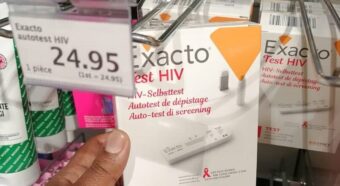Global Fund Policy Corner: Allocation Methodology
- January 27, 2023
- Africa / African Constituencies / The Global Fund
- By Armelle Nyobe
- Read in French

The Global Fund’s 7th replenishment raised US$15.7 billion in pledges to be used for the 2023-2025 funding cycle. Implementing countries will soon receive their allocation letters indicating how much they can receive for the next cycle with a proposed split by component/disease. It is advisable to look at the Allocation Methododology to “determine the funding amount for countries, with an indicative split for HIV, TB and malaria.”
Figure 1: Overview of the Allocation Methodology

Source: https://www.theglobalfund.org/fr/applying-for-funding/sources-of-funding/allocation-funding/
The allocation formula
The allocation formula allocates funding to countries based on two criteria: their disease burden compared to that of all eligible countries and the countries’ economic capacity. The allocation formula provides more funding to countries with lower abilities to fund responses to the three diseases (health system strengthening is not included here).
For all countries eligible for funding for each disease, the amount allocated for a given disease is calculated by multiplying their disease burden by their country economic capacity. Each country’s disease burden, multiplied by its economic capacity, is then divided by the sum of disease burden multiplied by the economic capacity for all eligible countries, which produces each country’s share. This is then multiplied by the total funding available for the disease to obtain the amount of funds allocated.
Additionally, the calculation is then refined to account for important contextual factors through a qualitative adjustment process conducted in a transparent and accountable manner.
Below is an example of how a country’s gross allocation is calculated in the case of malaria:
Figure 2: Allocation formula

Source: https://www.theglobalfund.org/media/9361/fundingmodel_2020-2022allocations_methodology_fr.pdf
Catalytic Funds: Additional Funding Sources
Catalytic funds are a pool of available funding for programs and activities that are critical to achieving the goals of the Global Fund strategy and partners’ plans, but that cannot be covered by country allocations alone.
Catalytic funds include:
Multi-country Catalytic Funds
The Global Fund provides allocations by country, but diseases don’t respect borders. Sometimes, the most effective solution to a problem is one that is found through collaboration across several countries or regions. Through multi-country funding, countries can address a limited number of common multicountry priorities with Global Fund financing. These catalytic investments complement those made with the amounts calculated through the allocation methodology.
The table below shows a list of strategic priorities for multi-country catalytic investments during the 2023-2025 allocation period. The funding levels and disbursement modalities were approved by the 48th Global Fund Board.
Table 1: List of Strategic Priorities for Catalytic Multi-Country Investments
| HIV | Key populations sustainability and impact |
| Malaria | Malaria Elimination in Southern Africa
Resistance to Artemisinin Initiative |
| RSSH | Empowering regional reference laboratories and national diagnostic networks |
Source: https://www.theglobalfund.org/fr/applying-for-funding/sources-of-funding/allocation-funding/
Catalytic Matching Funds
Table 2: List of priority areas for the use of matching funds during the 2023-2025 allocation period.
| Components | Matching Funds are designed to inspire innovation and ambitious, evidence-based programming approaches to increase impact in specific strategic priority areas. |
| HIV | Prevention for key populations, adolescent girls and young women, and their sexual partners. |
| TB | Find and successfully treat the missing people with drug-susceptible and drug-resistant tuberculosis (TB).
Scale up TB prevention. Country readiness for innovation and quality TB programming.
|
| Malaria | Elimination of the disease in Southern Africa |
| RSSH (Resilient and Sustainable Systems for Health) | Scaling-up programs that remove human rights and gender-related barriers.
Incentivizing RSSH quality and scale. Effective community systems and responses that contribute to improved health outcomes, and equitable access to integrated people-centered quality services. Equitable access to quality health products through innovation, partnership, and promoting sustainable sourcing and supply chains at global, national, and community levels (NextGen Market Shaping ) |
Source: https://www.theglobalfund.org/fr/applying-for-funding/sources-of-funding/allocation-funding/
Strategic Initiatives
Table 3: List of Strategic Initiatives for the 2023-2025 allocation period.
| Components | Strategic initiatives are often managed by technical partners such as UN organizations, multi-country organizations or civil society organizations.
|
| HIV | Implementation support for innovation, precision and scale in HIV prevention.
|
| TB | Technical support for matching funds |
| Malaria | Biologic threats in malaria case management in Africa
E2030 – Drive towards eliminating the disease and preventing its recurrence Regional coordination and targeted technical assistance Addressing vector control threats and opportunities: supporting country readiness for new tools. |
| RSSH | Community engagement
Scaling-up programs to remove human rights- and gender-related barriers Empowering regional reference laboratories and national diagnostic networks Data Effective community systems and responses that contribute to improved health outcomes, and equitable access to integrated people-centered quality services. Equitable access to quality health products through innovation, partnership, and promoting sustainable sourcing and supply chains at global, national, and community levels ( Next Market Shaping ) Health sector financing |
Source: https://www.theglobalfund.org/fr/applying-for-funding/sources-of-funding/allocation-funding/
Training Sessions on the 2023-2025 Allocation Period
The Global Fund has organized a series of webinars for CCMs interested in learning more about the 2023-2025 funding requests. Broadly speaking, not only CCMs, but also technical assistance providers, technical partners and others involved in the preparation of funding requests are invited to register.
To register for a session you are interested in, simply click on the session title below.
| Session | Date |
| Matching Funds | 9 January |
Armelle NYOBE
Sources



Ihope this working together is going bring better results in the world